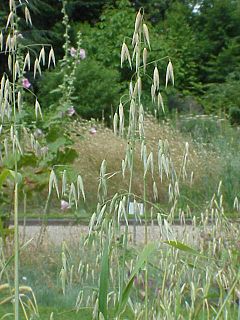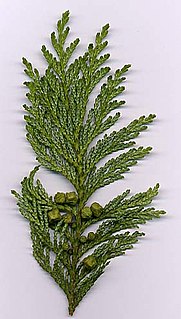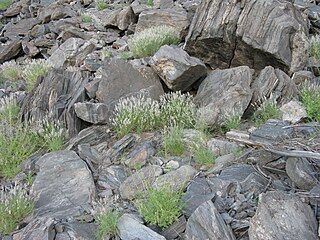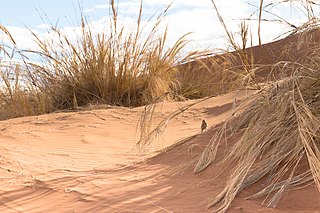
Avena is a genus of Eurasian and African plants in the grass family. Collectively known as the oats, they include some species which have been cultivated for thousands of years as a food source for humans and livestock. They are widespread throughout Europe, Asia and northwest Africa. Several species have become naturalized in many parts of the world, and are regarded as invasive weeds where they compete with crop production. All oats have edible seeds, though they are small and hard to harvest in most species.

The Cyperaceae are a family of graminoid (grass-like), monocotyledonous flowering plants known as sedges. The family is large, with some 5,500 known species described in about 90 genera, the largest being the "true sedges" genus Carex with over 2,000 species.

Chamaecyparis, common names cypress or false cypress, is a genus of conifers in the cypress family Cupressaceae, native to eastern Asia and to the western and eastern margins of the United States. The name is derived from the Greek khamai (χαμαί), meaning "on the earth", and kuparissos (κυπάρισσος) for "cypress".

The Restionaceae, also called restiads and restios, are a family of flowering plants native to the Southern Hemisphere; they vary from a few centimeters to 3 meters in height. Following the APG IV (2016): the family now includes the former families Anarthriaceae, Centrolepidaceae and Lyginiaceae, and as such includes 51 genera with 572 known species. Based on evidence from fossil pollens, the Restionaceae likely originated more than 65 million years ago during the Late Cretaceous period, when the southern continents were still part of Gondwana.

Panicum (panicgrass) is a large genus of about 450 species of grasses native throughout the tropical regions of the world, with a few species extending into the northern temperate zone. They are often large, annual or perennial grasses, growing to 1–3 m tall.

Barleria is a genus of plants in the family Acanthaceae.

Plumeria obtusa, the Singapore graveyard flower, is a species of the genus Plumeria (Apocynaceae). It is native to the West Indies, southern Mexico, Belize, Guatemala, and Florida. but widely cultivated for its ornamental and fragrant flowers around the world, where suitably warm climate exists. It is reportedly naturalized in China.

Eriachne is a genus of plants in the grass family. Most of the species are found only in Australia, with the ranges of a few extending northward into New Guinea, parts of Asia, and Micronesia.

Enteropogon is a genus of tropical and subtropical plants in the grass family. It is widespread across many parts of Asia, Africa, Australia, the Americas, and various islands.
Pariana is a genus of tropical American plants in the grass family.

The Aristideae is the sole tribe of grasses in the monotypic subfamily Aristidoideae of the true grass family Poaceae. Its members are herbaceous annuals or perennials found in the tropics, subtropics and temperate zones. The tribe has over 300 species in three genera: The subfamily is a member of the PACMAD clade of grasses, the evolutionary group in which C4 photosynthesis independently evolved a number of times.

Giuseppe De Notaris was an Italian botanist generally known for his work with cryptogams native to Italy.

Stipagrostis obtusa is a perennial grass belonging to the grass family (Poaceae). It is a widespread species, being native to North Africa, Mauritania, Chad, Ethiopia, Southern Africa, Western Asia, the Arabian Peninsula and Pakistan.

Nitellopsis obtusa is a large freshwater alga. It is also known by the common name starry stonewort. This alga grows to a length of over 1.5 metres, is bright translucent green and has branches growing in whorls from the main axis the plants easily break up. It is easily distinguished from other charophytes by star-shaped bulbils which permit vegetative reproduction.
Eragrostis truncata is a grass native to Namibia, Botswana, and South Africa. Found most abundantly in the Nama Karoo, the plant is registered under the SANBI Red List as "safe" (LC).

Stipagrostis namaquensis is a species of grass native to South Africa and Namibia, especially in the Nama Karoo. It is listed as "safe" (LC) on the SANBI Red List.

Stipagrostis sabulicola, the Namib dune bushman grass, is a species of grass endemic to the dunes of the Namib desert. The perennial grass grows up to 200cm tall and has a wide system of shallow roots, allowing it to catch water in the form of fog and dew, additional to rain.

Stipagrostis uniplumis is a perennial grass belonging to the grass family (Poaceae). It is the most common of the Stipagrostis species and occurs in most of the arid parts of Africa as far north as Senegal and Somalia.
Stipagrostis hirtigluma is a densely tufted perennial grass. It occurs across most of Africa east to Pakistan in bushveld, karoo, and desert regions. In Namibia, it grows in dry, warm parts, in stony or sandy places and on rocky outcrops.
















